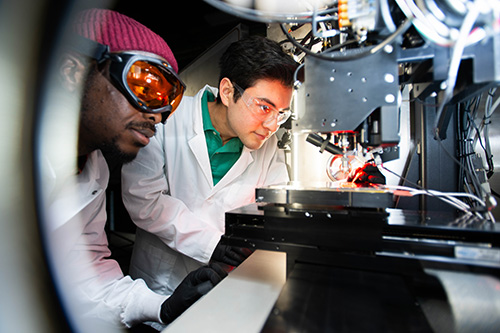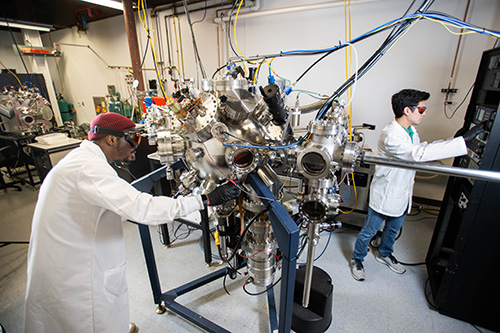Wednesday, August 14, 2024

Students work on semiconductor-related research at UNT's Discovery Park
The Center for Microelectronics in Extreme Environments will focus on advancing the development of next-generation semiconductors, supporting regional and state efforts to grow the industry and train the future semiconductor workforce.
Semiconductors are the building blocks of electronics and drive modern society from artificial intelligence, internet of things, cellphones and computers to medical equipment, autonomous vehicles and systems used for the nation’s defense. In a world increasingly reliant on technology and innovations spurring the need for more advanced components, semiconductors are more important than ever.
To further fuel research on semiconductors, the University of North Texas launched a new research center — the Center for Microelectronics in Extreme Environments (CMEE).
A UNT College of Engineering and College of Science multidisciplinary center, CMEE will focus on advancing the development of next-generation semiconductors, supporting regional and state efforts to grow the industry and train the future semiconductor workforce. It brings together expertise from more than a dozen faculty members in materials science, physics, chemistry, electrical engineering and mechanical engineering.
“This center aligns UNT’s existing expertise in materials research and will foster more interdisciplinary collaboration and funding opportunities, as well as technology innovation that is critical for our economy,” said Pamela Padilla, UNT’s vice president for research and innovation.
“Our efforts also will help build a more sustainable semiconductor workforce pipeline in Texas and beyond by ensuring our students have the breadth of expertise and entrepreneurial mindset they’ll need for success in this rapidly changing industry.”
Focus on High-Power Electronics
The center’s main research emphasis will be on creating semiconductors that are needed for high-power electronic devices for commercial use, but also for more specialized applications needed by government agencies like the U.S. Department of Defense, U.S. Department of Energy and NASA.
“High-power, high-frequency semiconductor materials and devices are needed for a wide variety of applications,” said Nigel Shepherd, associate professor of materials science and engineering, who will serve as the center’s director along with co-director Usha Philipose, professor of physics.
“In use, they need to function in pretty much every environment you could think of including conditions such as radiation exposure, high and low temperatures, mechanical shock and high pressures, among others. When materials fail, applications fail so understanding their performance limits is crucial. The knowledge from our research will lead to devices that can better withstand these extreme operating conditions.”
Through UNT’s research facilities across campus, it can simulate extreme conditions
for testing materials and devices. For example, the College of Science’s ion beam
accelerator lab — the only university facility in the nation capable of performing
elemental and ion-induced charge mapping in electronics materials and devices at a
sub-micrometer scale — will be used in the research. At UNT’s 300-acre Discovery Park,
the largest research park in the North Texas region, researchers have access to UNT’s
Materials Research Facility (MRF) — one of the most advanced university research facilities
in the nation for materials analysis, which includes the only 3D atom probe system
in the state.
Boosting the Industry
There’s been big moves in recent years on the federal and state levels to boost the U.S. semiconductor industry. In 2022, the U.S. passed the CHIPS Act approving $280 billion in new funding to advance domestic research and manufacturing of semiconductors.
Texas is the largest semiconductor exporter in the nation and is No. 1 in semiconductor manufacturing capacity accounting for 36% of the U.S. total. Last year, it approved its own CHIPS Act, which included the formation of a group of experts to advise the state on its strategic planning to secure Texas’ leadership in semiconductors. In March, Gov. Greg Abbott announced the inaugural members of the Texas Semiconductor Innovation Consortium (TSIC), which includes UNT’s Shepherd.
“I’m honored to be UNT’s TSIC representative and contribute to the state’s planning to enhance semiconductor research, innovation, manufacturing and securing leadership of the sector,” Shepherd said.
 The North Texas region has long been a leader in semiconductor innovation. The integrated
circuit was invented at Dallas-based Texas Instruments. In more recent years, the
region has continued to expand its presence in the industry with the opening of new
manufacturing and design facilities for semiconductors.
The North Texas region has long been a leader in semiconductor innovation. The integrated
circuit was invented at Dallas-based Texas Instruments. In more recent years, the
region has continued to expand its presence in the industry with the opening of new
manufacturing and design facilities for semiconductors.
Building on collaborations with industry, academic institutions and the current research centers at UNT, the overall objective for CMEE is to expand the semiconductor ecosystem at UNT.
“The center’s capabilities and faculty expertise will not just strengthen semiconductor research and innovation efforts but will train the next generation of scientists and engineers to meet the emerging workforce needs,” Philipose said.
UNT News Service Phone Number: (940) 565-2108
Media Contacts:
Amanda Lyons
Amanda.Lyons@unt.edu
940-565-2943
From UNT News – General News